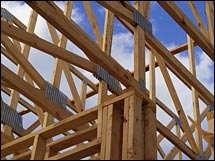NEW YORK (CNN/Money) -
Rising raw material prices. Shortages of some basic materials. The prospects of higher interest rates.
 |
|
| The price of framing lumber is up close to 50 percent from a year ago, but that hasn't been enough to slow new home building. |
You wouldn't think this would be the best environment for home building. But the numbers, and forecasts, show new home building will set a record this year --and even a slight decline next year would result in the second best year ever.
In a report Tuesday, July housing starts rose more than 8 percent to an annual rate of 1.98 million units, far above the consensus forecast of 1.90 million units. Building permits, an indication of builders' confidence in the market, rose 5.7 percent to a 2.06 million annual rate.
It marked the third time in 2004 that permits topped the 2 million rate, suggesting they're not being held back by a rise in costs.
Prices for lumber, cement, gypsum wall board and insulation are all up more than 10 percent from year-ago levels, with lumber close to 50 percent higher. And all the products except for lumber have seen spot shortages around the country that have put some building projects on hold.
The National Association of Home Builders estimates that the rise in materials prices is adding $7,000 to the cost of the average home. And prices could go higher still due to further demand for building materials, particularly plywood and other wood boards in Florida following billions of dollars in damage caused by Hurricane Charley.
"The biggest factor (in raw material costs) is we're at record levels of residential construction," said Michael Carliner, economist for the trade group.
He said growing demand from China is also a factor, particularly for cement prices, and that while it's too soon to judge the impact of Charley, it is likely to be felt as well.
"We're bumping up against capacity limits already," he said. "We don't expect to see prices jumping much beyond where they are, but we do see them stay at these elevated levels for some time."
Carliner said the higher prices are probably putting the brakes on home renovation work and some custom construction, which are both generally more price sensitive than the majority of new home building. He says he wasn't surprised by strong housing starts and building numbers because price hikes are bringing more buyers into the market than they are scaring away.
"When prices go up, buyers say, 'Look how much money I would have saved if I bought last year, and if I don't buy now, I won't be able a new home next year,'" said Carliner.
Mortgage rates spurring sales
Mortgage rates, up about a half percentage point since falling to near 40-year lows in March, also aren't dragging on housing. That's partly because mortgage rates rose nearly a full percentage point from March before retreating to current levels, giving some potential buyers incentive to rush into the new home market now that rates have eased again.
"You want to get your house in place before financing costs go up," said Ethan Harris, chief economist for Lehman Brothers.
Harris said that even with the Federal Reserve following a policy of higher interest rates, he doesn't expect long-term rates, which are closely tied to mortgage rates, to go much higher until at least the fall. He doubts rates will increase sharply over the next year, given general market conditions and the weakening U.S. economic recovery.
The relatively weak performance of the stock market this year is another factor that continues to support housing, according to Harris.
"You think of the average Joe as a momentum investor, following whatever has been hot recently," he said . "There's been a view of the house as a safe place to put your savings. If the stock market was doing better, there might be less frenzy to buy homes."
Harris said it's not that people are buying income property, but rather see their own home as providing the best return. And potential buyers who are saving to put a down payment on a house are finding their savings languishing while housing prices go up.
Those factors work together to prompt buyers to jump into the market sooner rather than later, he added.
But Harris is worried that the current pace of building can not be sustained.
"When you buy to beat the price increase, that's a sure sign of bubble behavior," he said. "The good news is housing markets generally don't pop like a bubble, they fizzle. People still need to live in a house, so they don't drop it like an Internet stock. But it does argue for sustained period of slowing construction, anemic home prices."
However, home builders' economist Carliner said his group isn't seeing any sharp drop in building or prices through at least 2005.
The group's 2004 forecast is for single-family starts to reach a record 1.56 million, up from 1.5 million in 2003. And while it forecasts single-family starts to decline to 1.51 million next year, it believes continued price increases will keep the value of new single-family homes relatively level next year.

|

